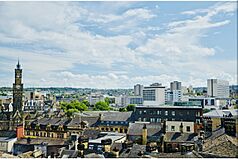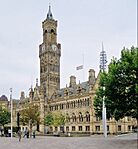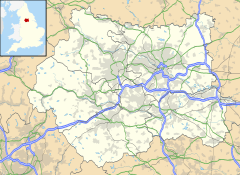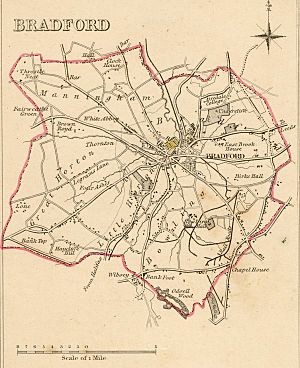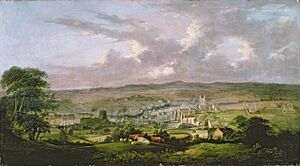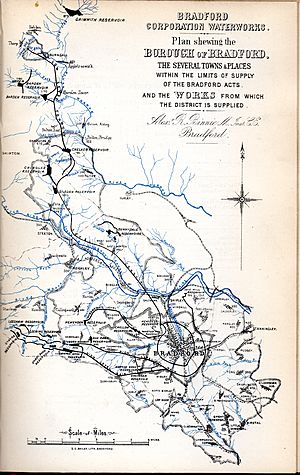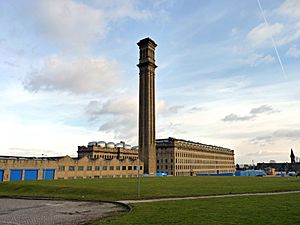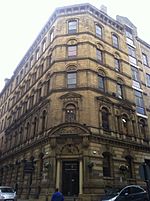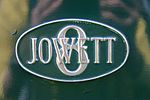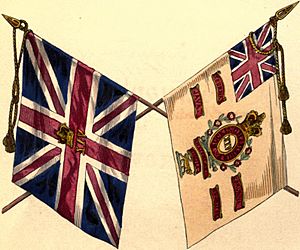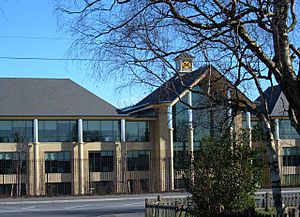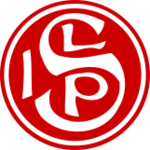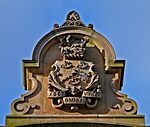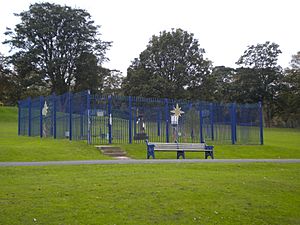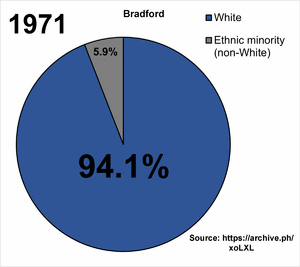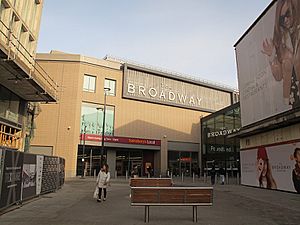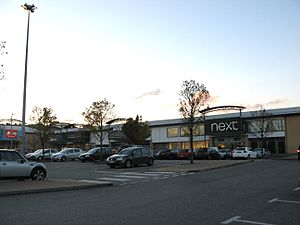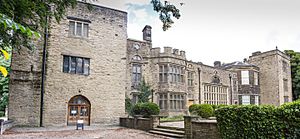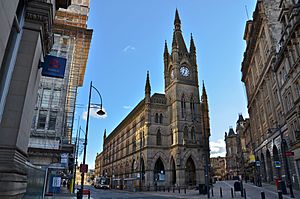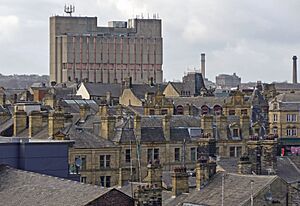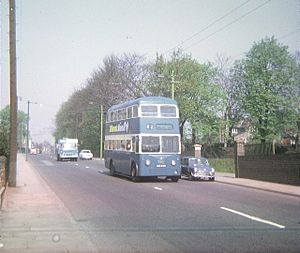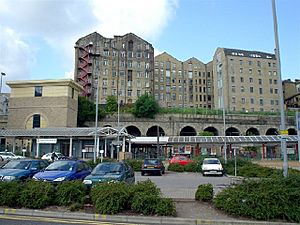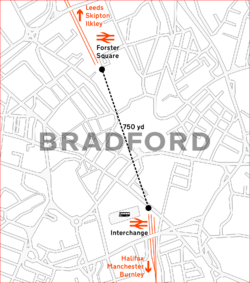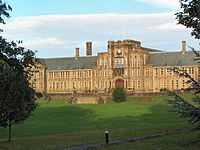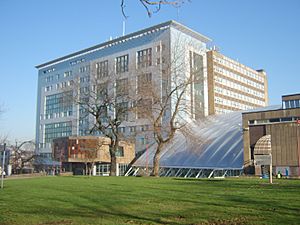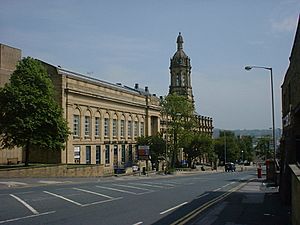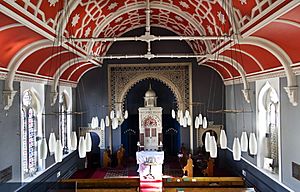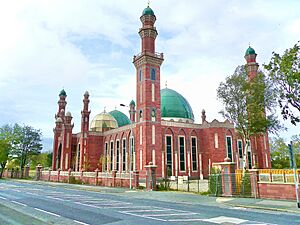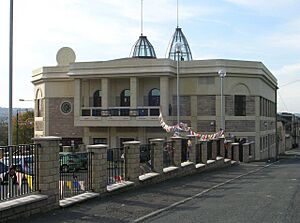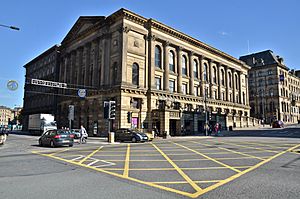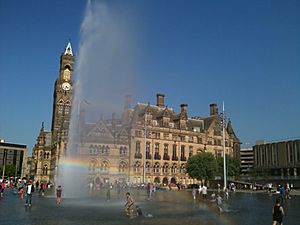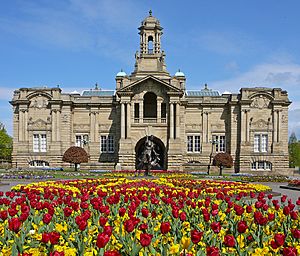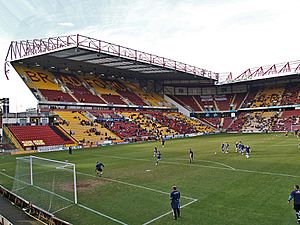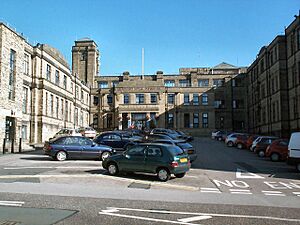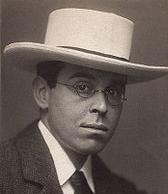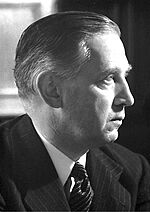Bradford facts for kids
Quick facts for kids Bradford |
|
|---|---|
| City | |
|
|
|
 Coat of arms of Bradford |
|
| Area | 141.313 sq mi (366.00 km2) |
| Population | 546,976 |
| • Density | 3,871/sq mi (1,495/km2) |
| Demonym | Bradfordian |
| OS grid reference | SE163329 |
| • London | 174 mi (280 km) S |
| Metropolitan borough | |
| Metropolitan county | |
| Region | |
| Country | England |
| Sovereign state | United Kingdom |
| Post town | BRADFORD |
| Postcode district | BD1–BD24 |
| Dialling code | 01274/ 01535 |
| Police | West Yorkshire |
| Fire | West Yorkshire |
| Ambulance | Yorkshire |
| EU Parliament | Yorkshire and the Humber |
| UK Parliament |
|
Bradford is a vibrant city located in West Yorkshire, England. It became a city in 1897. Since 1974, the city status has applied to the larger City of Bradford area. In 2011, Bradford had a population of 349,561 people. This made it the second-largest part of the West Yorkshire Built-up Area, after Leeds. The wider district had a population of 546,976 in 2021.
Historically, Bradford was a major global hub for textile making, especially wool. It was a "boomtown" during the Industrial Revolution. It quickly became known as the "wool capital of the world." This led to nicknames like "Woolopolis" and "Wool City." The area had easy access to coal, iron ore, and soft water. These resources helped its manufacturing grow. This growth caused a huge increase in population and led to many civic improvements. You can still see lots of beautiful Victorian architecture in the city, like the grand Italian-style City Hall.
From the mid-1900s, the textile industry declined. Bradford then faced challenges similar to other post-industrial cities in Northern England. Today, its economy is worth about £10 billion. This comes mostly from finance and manufacturing. Bradford is also a popular place for tourists. It was the first UNESCO City of Film. It has the National Science and Media Museum, City Park, the Alhambra Theatre, and Cartwright Hall. Bradford was named the UK City of Culture for 2025. It won this title on May 31, 2022.
Contents
- Bradford's Past: A Journey Through Time
- How Bradford is Governed
- Bradford's Geography and Climate
- Bradford's People and Economy
- Bradford's Famous Landmarks
- Getting Around Bradford
- Education in Bradford
- Religion in Bradford
- Bradford's Culture and Arts
- Sports in Bradford
- Public Services in Bradford
- Famous People from Bradford
- Bradford's International Connections
- Images for kids
- See also
Bradford's Past: A Journey Through Time
What's in a Name?
The name Bradford comes from old English words. Brad means "broad" and ford means "a shallow river crossing." It refers to a place where people crossed the Bradford Beck. This crossing was near where Bradford Cathedral stands today. A settlement grew around this spot in Anglo-Saxon times. In 1086, it was written as "Bradeford."
Early Beginnings
After an uprising in 1070, the area of Bradford was left in ruins. This is mentioned in the Domesday Book of 1086. Bradford then became part of the Honour of Pontefract. This land was given to Ilbert de Lacy. He served William the Conqueror. The Lacy family owned the land until 1311. There are signs that a castle existed during their time.
By the Middle Ages, Bradford was a small town. It was centered around Kirkgate, Westgate, and Ivegate. In 1316, there was a mill for processing wool and a market. During the Wars of the Roses, the people of Bradford supported the House of Lancaster. King Edward IV later allowed the town to hold two yearly fairs. From then on, the town began to grow. By the time of King Henry VIII, Bradford was a bigger manufacturing center than Leeds. The wool trade helped Bradford grow slowly for the next two hundred years.
During the English Civil War, Bradford supported the Parliamentarians. In 1642, Royalist forces from Leeds attacked but failed. Sir Thomas Fairfax led the Parliamentarians. They were defeated and retreated to Bradford. The Royalists then surrounded the town from Bolling Hall. Bradford surrendered. The Civil War caused a decline in industry. But after William III and Mary II became rulers in 1689, prosperity returned. New factories started in the early 1700s. New canals and turnpike roads also helped trade grow.
The Industrial Revolution and Growth
In 1801, Bradford was a small rural market town with 6,393 people. Wool spinning and cloth weaving were done in homes. Bradford was similar in size to nearby Keighley and smaller than Halifax or Huddersfield. The town served as a center for three nearby areas: Manningham, Bowling, and Great and Little Horton. These were separated by countryside.
Ironworks were set up around 1788. The Low Moor Company made iron and employed many people. By 1847, when Bradford became a municipal borough, there were 46 coal mines within its borders. Coal production peaked in 1868. Bradford produced a quarter of all coal and iron in Yorkshire.
The population of the township reached 34,560 by 1841.
In 1825, wool workers went on strike for five months. But they had to return to work due to hardship. This led to machines doing the wool-combing. The Industrial Revolution brought fast growth. Huge amounts of wool were imported for making worsted cloth. Bradford became famous for this. Soon, it was known as the wool capital of the world.
A military base was built in the town. Bradford Moor Barracks was finished in 1844.
Bradford became a municipal borough in 1847. It became a county borough in 1888. This made it independent from the West Riding County Council. Queen Victoria gave Bradford city status in 1897. This was for her Diamond Jubilee. Bradford, Kingston upon Hull, and Nottingham were the largest county boroughs outside London without city status. The city's borders grew in 1930 and 1937.
Bradford had plenty of local coal for power. Local sandstone was great for building mills. By 1850, the population was 182,000. The town grew quickly as people came for jobs in the textile mills. A big problem was the lack of water in Bradford Dale. This limited industrial growth and made city hygiene difficult. In 1854, Bradford Corporation bought the Bradford Water Company. They started a huge project to bring soft water from other valleys. By 1882, the water supply was much better. The city also expanded, and by the late 1800s, the separate townships became one continuous urban area.
A major employer was Titus Salt. In 1833, he took over his father's wool business. He specialized in fabrics mixing alpaca, mohair, cotton, and silk. By 1850, he had five mills. But because of the pollution and poor conditions for his workers, Salt left Bradford. He moved his business to Salts Mill in Saltaire in 1850. There, in 1853, he started building a village for his workers. This village is now a UNESCO World Heritage Site.
Henry Ripley was another important figure. He managed Edward Ripley & Son Ltd, which owned the Bowling Dye Works. In 1880, the dye works employed over 1000 people. It was said to be the biggest dye works in Europe. Like Salt, he was a councillor and cared about improving housing for workers. He built the Model village of Ripley Ville near the dye works.
Other big employers were Samuel Lister and his brother. They were wool spinners and manufacturers at Lister's Mill. Lister was a symbol of Victorian business.
Rapid growth caused problems. Over 200 factory chimneys constantly released black smoke. Bradford became known as the most polluted town in England. There were often outbreaks of diseases.
Many immigrants came to Bradford. In the 1840s, many people from Ireland moved to Bradford. By 1851, about 10% of the population was born in Ireland.
In the 1820s and 1830s, people also immigrated from Germany. Many were Jewish merchants. They became very active in the town. The Jewish community, mostly in Manningham, had about 100 families. But they were important in making Bradford a major exporter of wool. Their textile export businesses were mainly in Little Germany. Charles Semon (1814–1877) was a textile merchant and helper. He built a successful textile export business. In 1864, he became the first foreign and Jewish mayor of Bradford. Jacob Behrens (1806–1889) was the first foreign textile merchant to export wool from the town. His company grew into a huge international business. Behrens was a helper and helped start the Bradford Chamber of Commerce in 1851. Jacob Moser (1839–1922) was a textile merchant. He was a partner in Edelstein, Moser and Co. This became a successful textile export business. Moser was a helper. He founded the Bradford Charity Organisation Society. In 1910, Moser became the first Jewish Lord Mayor of Bradford.
To support the textile mills, a large manufacturing industry grew. This led to other industries thriving. The Jowett Motor Company started in the early 1900s. They made cars and vans in Bradford for 50 years. The Scott Motorcycle Company was a famous maker of motorcycles and small engines. It was founded by Alfred Angas Scott in 1908. Scott motorcycles were made until 1978.
Bradford's Role in Politics and War
The city played an important part in the early history of the Labour Party. A mural behind the Bradford Playhouse in Little Germany celebrates 100 years since the Independent Labour Party was founded in Bradford in 1893.
The Bradford Pals were three special battalions of soldiers. They were formed in the city during the First World War. On July 1, 1916, the 16th and 18th Battalions advanced in France. This was the first day of the Battle of the Somme. Out of about 1,394 men from Bradford, 1,060 were killed or injured. Other Bradford battalions also fought in the Battle of the Somme.
Recent History and Modern Bradford
After the Second World War, migrants came from Poland and Ukraine. Since the 1950s, people have come from Bangladesh, India, and especially Pakistan.
The textile industry has been shrinking since the late 1900s. But Bradford has always been a place of innovation. New textile technologies were invented here. This spirit of innovation continues today. It can be seen in car design (Kahn Design) and electronics (Pace Micro Technology). Wm Morrison Supermarkets was started by William Morrison in 1899. It began as an egg and butter seller in Rawson Market.
The grandest mills are no longer used for textiles. Lister Mills is one example. Its chimney can be seen from most places in Bradford. It has been transformed into apartment blocks. This was a £100 million project.
In 1989, copies of Salman Rushdie's The Satanic Verses were burned in the city. Some members of the Muslim community protested the book. In July 2001, tensions led to rioting.
The Yorkshire Building Society opened its new headquarters in Bradford in 1992.
In 2006, Wm Morrison Supermarkets opened its new headquarters in the city. The company employs over 5,000 people in Bradford.
In June 2009, Bradford became the world's first UNESCO City of Film. It joined the Creative Cities Network. The city has a long history of making films and film technology. This includes the invention of the Cieroscope in 1896.
In 2010, Provident Financial opened its new headquarters in the city. The company has been based in Bradford since 1880.
In 2012, the British Wool Marketing Board opened its new headquarters here. Also in 2012, Bradford City Park opened. The park cost £24.5 million to build. It is a public space with fountains and a mirror pool.
In 2015, The Broadway shopping and leisure complex opened. It cost £260 million to build.
In 2022, Bradford was chosen as the UK City of Culture 2025. It beat Southampton, Wrexham, and Durham. This title is expected to boost the local economy and culture. It will also attract tourists. By 2025, the UK City of Culture is expected to bring £389 million in economic growth. It will also create over 7,000 jobs.
How Bradford is Governed
Bradford played a key role in the early days of the Labour Party. A mural on the Bradford Playhouse celebrates the 100th anniversary of the Independent Labour Party in 1893. Its motto was "There is no weal save commonweal."
The original Bradford Coat of Arms had the Latin words Labor omnia vincit. This means "Work conquers all." A new coat of arms was created in 1976. It has the English motto "Progress, Industry, Humanity."
Bradford is represented by three Members of Parliament (MPs). These are for Bradford East, Bradford South, and Bradford West. All three MPs are from the Labour Party.
The City of Bradford Metropolitan District Council has 90 councillors. As of 2023, the Labour Party had majority control with 56 seats. The council was led by Susan Hinchliffe.
Bradford's Geography and Climate
Bradford is located in the eastern foothills of the South Pennines moorland region.
The city is not built on a large river. It is at the meeting point of three valleys. One valley is formed by the Bradford Beck. This stream starts in the moors to the west. It is joined by other streams. At the original ford, the beck turns north. It flows towards the River Aire at Shipley. This valley is sometimes called Bradfordale. The beck flows underground through the city center.
The Bradford Canal was built in 1774. It connected the city to the Leeds and Liverpool Canal. It used water from the Bradford Beck. The canal was often polluted and closed permanently in 1922. You can still see parts of the old canal route today.
 |
The Yorkshire Dales, Skipton, Keighley, Bingley, Cottingley, Heaton | The Yorkshire Dales, Ilkley, Otley, Guiseley, Baildon, Shipley, Saltaire | York, Wetherby, Harrogate, Leeds Bradford Airport, Greengates, Eccleshill |  |
| University of Bradford, Thornton, Denholme, Oxenhope, Haworth, Hebden Bridge, Todmorden, Burnley | Thornbury, Pudsey, Leeds, Selby | |||
| Wibsey, Buttershaw, Clayton, Queensbury, Halifax, Rochdale, Oldham, Manchester | Wyke, Oakenshaw, Bailiff Bridge, Cleckheaton, Brighouse, Huddersfield, Holmfirth | East Bowling, Tong, Morley, Batley, Dewsbury, Ossett, Wakefield |
Geology and Landscape
The city's ground is mostly made of carboniferous sandstone. This stone varies in quality. It ranges from rough rock to fine, honey-colored building stone. Having this material nearby greatly influenced the city's architecture. Bradford is also in the northern part of the South Yorkshire Coalfield. This area has a lot of coal. Coal mining helped the city grow early on. Today, less mining happens.
Bradford's Climate
Like most of the UK, Bradford has a maritime climate. This means temperatures don't change much between seasons. Rainfall is moderate throughout the year. Weather records have been kept since 1908 at Lister Park. This is one of the longest continuous weather records in the country.
The highest temperature ever recorded was 37.9°C in July 2022. In an average year, the warmest day reaches about 27.5°C. Temperatures of 25.1°C or higher happen about 6 days a year.
The lowest temperature ever recorded was -13.9°C in January 1940. Because the weather station is in a higher suburban area, extremely low temperatures are rare. On average, there are about 41.4 nights with frost each year.
Rainfall is around 870 mm per year. It rains more than 1 mm on about 139 days.
Sunshine is low, at just over 1,250 hours per year. This is typical for an inland area in Northern England among hills. All these averages are based on the 1981–2010 period.
| Climate data for Bradford (Lister Park), elevation: 134 m (440 ft), 1991–2020 normals, extremes 1908–present | |||||||||||||
|---|---|---|---|---|---|---|---|---|---|---|---|---|---|
| Month | Jan | Feb | Mar | Apr | May | Jun | Jul | Aug | Sep | Oct | Nov | Dec | Year |
| Record high °C (°F) | 14.6 (58.3) |
18.4 (65.1) |
21.7 (71.1) |
23.9 (75.0) |
26.7 (80.1) |
30.0 (86.0) |
37.9 (100.2) |
32.2 (90.0) |
27.2 (81.0) |
25.6 (78.1) |
17.1 (62.8) |
15.8 (60.4) |
37.9 (100.2) |
| Mean daily maximum °C (°F) | 6.8 (44.2) |
7.4 (45.3) |
9.5 (49.1) |
12.5 (54.5) |
15.7 (60.3) |
18.2 (64.8) |
20.4 (68.7) |
19.8 (67.6) |
17.2 (63.0) |
13.4 (56.1) |
9.6 (49.3) |
7.2 (45.0) |
13.1 (55.6) |
| Daily mean °C (°F) | 4.3 (39.7) |
4.6 (40.3) |
6.2 (43.2) |
8.6 (47.5) |
11.5 (52.7) |
14.2 (57.6) |
16.3 (61.3) |
15.9 (60.6) |
13.5 (56.3) |
10.3 (50.5) |
6.8 (44.2) |
4.6 (40.3) |
9.7 (49.5) |
| Mean daily minimum °C (°F) | 1.8 (35.2) |
1.8 (35.2) |
2.9 (37.2) |
4.7 (40.5) |
7.2 (45.0) |
10.1 (50.2) |
12.2 (54.0) |
12.0 (53.6) |
9.9 (49.8) |
7.1 (44.8) |
4.1 (39.4) |
2.0 (35.6) |
6.3 (43.3) |
| Record low °C (°F) | −13.9 (7.0) |
−13.3 (8.1) |
−11.1 (12.0) |
−10.6 (12.9) |
−3.0 (26.6) |
0.6 (33.1) |
5.0 (41.0) |
2.8 (37.0) |
0.3 (32.5) |
−4.1 (24.6) |
−7.8 (18.0) |
−13.1 (8.4) |
−13.9 (7.0) |
| Average precipitation mm (inches) | 88.4 (3.48) |
73.8 (2.91) |
64.0 (2.52) |
57.8 (2.28) |
52.0 (2.05) |
72.5 (2.85) |
64.2 (2.53) |
73.7 (2.90) |
69.5 (2.74) |
84.4 (3.32) |
90.3 (3.56) |
99.0 (3.90) |
889.6 (35.02) |
| Average precipitation days (≥ 1.0 mm) | 14.4 | 12.1 | 11.3 | 10.6 | 9.9 | 10.1 | 10.3 | 11.5 | 10.7 | 12.5 | 14.3 | 14.5 | 142.1 |
| Mean monthly sunshine hours | 43.2 | 67.7 | 105.2 | 142.1 | 173.3 | 159.4 | 167.2 | 156.1 | 122.8 | 89.7 | 54.9 | 38.0 | 1,319.4 |
| Source 1: Met Office | |||||||||||||
| Source 2: ECA&D | |||||||||||||
Green Spaces and Nature
Bradford is surrounded by a green belt area. This helps stop the city from spreading too much. It also protects the identity of smaller towns and villages. The green belt encourages outdoor activities. It includes places like Park Wood, Northcliffe park and woods, and Lister Park. In May 2025, West Yorkshire's first national nature reserve, Bradford Pennine Gateway, was created. It includes parts of Penistone Hill, Shipley Glen, and Ilkley Moor.
Bradford's People and Economy
Who Lives in Bradford?
In 2011, Bradford had a population of 522,452. There were 106,680 households. The population density was 4,560 people per square kilometer. For every 100 females, there were 92.9 males. Bradford has one of the youngest and fastest-growing populations outside London.
The 2011 census showed that 67.44% of Bradford's population was White. 26.83% was Asian. 2.48% was Mixed Race. 1.77% was Black. 1.48% was from other races.
About 22.1% of the population is British South Asian. This is the second-highest percentage in a single settlement in England and Wales. Nearly half of all Asians in Yorkshire and the Humber live in Bradford. Some central areas like Bradford Moor and Manningham have large Asian populations. Outer areas like Thornton and Wibsey are mostly white.
| Ethnic group | Population | % |
|---|---|---|
| White | 333,850 | 61.6 |
| Asian or Asian British | 175,394 | 32.1 |
| Mixed | 14,753 | 2.7 |
| Black or Black British | 10,928 | 2.0 |
| Other Ethnic Group | 10,928 | 2.0 |
| Total | 546,400 | 100 |
Bradford's Economy Today
Bradford's textile industry has been shrinking for many years. The city has faced challenges from this change. However, Bradford's economy is strong. It is worth about £9.5 billion. This makes it a major economic force in the region. It is expected to grow to over £10 billion by 2018. This contributes about 8.4% of the region's output. Bradford is the third largest economy in Yorkshire & Humber.
The economy has become more diverse. The city is home to several big companies. These include finance companies like Yorkshire Building Society and Provident Financial. Textile companies like British Wool Marketing Board are also here. Other industries include chemicals (BASF), electronics (Arris International), and engineering (NG Bailey). Manufacturing companies like Hallmark Cards UK and Seabrook Potato Crisps are also based in Bradford. The supermarket chain Morrisons has its head office in Bradford. So does the water company Yorkshire Water.
Vanquis Banking Group, previously Provident Financial plc, moved into a large new headquarters. This building cost £45 million. It also has a 200-bed Jurys Inn hotel.
In October 2011, plans to improve Bradford city center received a boost. The council secured £17.6 million from the government. This money helped create a "growth zone." Companies in this zone get business rate relief. In return, they help people get training and jobs.
In April 2012, retail company Freeman Grattan Holdings opened a new head office. It moved about 300 staff to the city center. The company moved staff from its old base.
As of 2025, Bradford is working on city regeneration projects. These are linked to its successful City of Culture 2025 bid. One major project is turning the old Bradford Odeon building into "Bradford Live." This will be a £22 million music venue for 4,000 people. Other projects include:
- One City Park: A £30 million office building in Bradford City Park.
- High Point: A £11 million project turning an old building into apartments.
- Bradford Central Rail Station: A planned new train station.
- Darley Street Market: A £23 million market with three trading floors.
Some old buildings in the city center will be taken down. This includes the NCP car park. This will make space to improve the Bradford Interchange.
Shopping in Bradford
The Broadway is Bradford's main shopping center. It has over 70 stores. These include Next, River Island, H&M, and Primark.
Kirkgate Shopping Centre is also in the city center. It has 65 shops, an indoor market, and parking. It has stores like New Look and Boots. The center has been renovated. It will eventually be replaced by the "City Village" development. Primark will move to The Broadway.
Forster Square Shopping Park opened in 1995. It is next to the Forster Square Railway Station. It has over 20 large shops and food places. These include Next, Boots, and Asda Living.
Sunbridge Wells is an underground shopping complex. It has restaurants, bars, and shops. It is built in old Victorian tunnels.
Darley St. Market is a new shopping center opening in 2024. It will replace older city center markets.
Bradford's Famous Landmarks
Bradford's oldest building is the cathedral. For most of its history, it was a parish church. Few other medieval buildings remain. One is Bolling Hall, which is now a museum.
There are many beautiful Victorian buildings. Besides the mills, there is the City Hall. It has statues of English rulers, including Oliver Cromwell. There is also the old Wool Exchange. A large Victorian cemetery is at Undercliffe. Little Germany is a wonderful Victorian business area. Its name comes from 19th-century German Jewish immigrants. They ran businesses from these many listed buildings. After years of decay, many buildings have been turned into offices and homes. Paper Hall was saved and renovated in the 1990s. Eastbrook Hall in Little Germany was renovated in 2005. Prince Charles opened it as luxury apartments in 2008. Bradford also has historic hotels. These date back to the Victorian era. The Victoria Hotel and the Midland Hotel were built for business travelers.
Besides Undercliffe Cemetery, Bradford has seven other cemeteries. These are in Bowling, Clayton, North Bierley Thornton, Queensbury, Scholemoor, Thornton, and Tong.
Like many cities, Bradford lost some important buildings in the 1960s and 1970s. The Swan Arcade and the old Kirkgate Market were especially missed. In recent years, some buildings from that era have also been demolished.
The tall High Point building was finished in 1972. It was the headquarters of the Yorkshire Building Society. It is a good example of Brutalist architecture. It has been empty for decades.
Bradford's main art gallery is in the grand Edwardian Cartwright Hall in Lister Park. The National Science and Media Museum celebrates cinema and movies. It is the most visited museum outside London. It has an Imax cinema and other screens.
Also in the city is St George's Hall. This grand concert hall dates from 1853. It is the oldest concert hall in Britain. The Alhambra theatre was built in 1914. It was renovated in 1986.
The city district has 37 parks and gardens. Lister Park, with its boating lake and Mughal Water Gardens, was voted Britain's Best Park in 2006. Bowling Park hosts the annual Bradford Carnival.
Bradford City Park is a 6-acre public space in the city center. It has the largest man-made water feature in any UK city. A 4,000 square meter mirror pool has over 100 fountains. The tallest fountain is 30 meters high. When the pool is empty, City Park hosts events. Work on the £24 million project started in 2010. City Park officially opened in March 2012.
The Bradford Odeon was built in 1930. It was a music venue and cinema for over 3,000 people. It was the largest UK cinema outside London. It closed in 2000. There have been many campaigns to save and renovate it.
Memorials Around the City
- Bradford War Memorial
- Bradford Victoria Cross Memorial
- Bradford Pals Headstone
- Bradford City Fire Memorial
- Bradford City of Peace
- Bhopal Workers' Memorial Day Plaque
- Hiroshima & Nagasaki Plaque
- Ukrainian Grove, Jacobs Well
- 1932 Ukrainian Famine Memorial
- 1986 Chernobyl Disaster Memorial
Getting Around Bradford
Road Travel
Bradford was first connected to the turnpike road network in 1734. This was when the first Yorkshire turnpike was built.
Today, major roads connect Bradford. These include the A647 to Leeds and Halifax. The A650 goes to Wakefield and Keighley. The M606 connects Bradford to the national motorway network. It ends at the city's ring road.
Buses and Trolleybuses
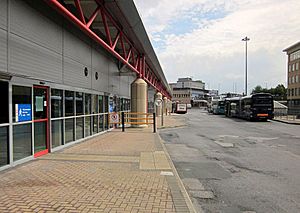
On June 20, 1911, Britain's first trolleybus systems opened. They started in Bradford and Leeds at the same time. The last trolleybus service in Bradford, and Britain, stopped on March 26, 1972. Ten Bradford trolleybuses are saved at the Sandtoft Trolleybus Museum. In 1974, Bradford's municipal buses became part of West Yorkshire Metro. First Bradford and Arriva Yorkshire are the main bus operators.
Rail Connections
The Leeds and Bradford Railway opened Forster Square railway station on July 1, 1846. It had service to Leeds. The station was rebuilt several times.
The Lancashire and Yorkshire Railway opened a station at Drake Street in 1850. The Great Northern Railway opened a third station, Adolphus Street, in 1854. But it was too far from the city center. The two companies built a joint station, Bradford Exchange, which opened in 1867. Adolphus Street became a goods terminal. In 1973, Exchange station was rebuilt. In 1983, it was renamed Bradford Interchange. A bus station was built next to it.
Forster Square and Bradford Interchange stations are part of the West Yorkshire Metro. There have been many ideas to connect Bradford's train stations.
A tram system started in Bradford in 1882. At first, horses pulled the trams. Then, steam engines were used in 1883. Electric trams started in 1898. The system ran until 1950.
Air Travel
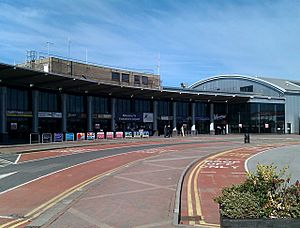
Leeds Bradford Airport is 6 miles northeast of the city. Bradford and Leeds councils jointly opened the airport in 1931. It is the home base for Jet2.com airlines. In May 2007, the councils sold the airport. The new owners planned to invest £70 million in improvements. They expected passenger numbers to increase to over 7 million by 2015.
Education in Bradford
Bradford Grammar School existed near the parish church in the mid-1500s. It was re-established by royal charter in 1662.
The University of Bradford has over 10,000 students. It received its royal charter in 1966. But its history goes back to the 1860s. It started as the Bradford Schools of Weaving, Design and Building. The university now teaches many subjects. These include technology, management, optometry, pharmacy, and archaeology. Its Peace Studies department started in 1973. For a long time, it was the only one in the UK.
The university is known for its research. It has departments like the Institute of Cancer Therapeutics and the Centre for Skin Sciences. The University of Bradford was ranked second in the UK for graduate employment in 2005.
In December 2010, the university was named the greenest in the UK for the second year. In 2019, it was named the UK's top university for social inclusion. For 2021 and 2022, it was the top university in England for social mobility.
Bradford College grew from a 19th-century technical college. It offers further and higher education courses. It is the UK's largest provider of higher-education courses outside universities. It has 23,000 students and 1,800 staff. The famous artist David Hockney studied at its Art School.
While in Bradford after 1892, Margaret McMillan joined the Fabian Society. She worked with her sister, Rachel, to improve children's welfare. They campaigned for free school meals. A college named after Margaret McMillan opened in 1952.
During the 2010s, many Bradford schools were ranked among the UK's best.
Religion in Bradford

Two carved stones were found at the site of Bradford Cathedral. They suggest Christians have worshipped here since AD 627. This was when Paulinus of York came to convert Northumbria. The most important Christian church in Bradford is Bradford Cathedral. It was originally the Parish Church of St Peter. The church became a cathedral in 1919.
Bradford has over 150 churches and chapels. Many Roman Catholic churches are a legacy of the large Irish population. They moved to Bradford in the 19th century.
The patron saint of Bradford is Saint Blaise. This is because he is linked to wool combing. His statue is on the Wool Exchange.
The city has a strong tradition of nonconformist churches. These include Congregationalists, Baptists, and Methodists. The Christian charity Christians Against Poverty was founded in the city. LIFE Church UK is a large nonconforming church with about 3,000 members.
The Jewish community was strong in the mid-to-late 19th century. They built Bradford Reform Synagogue in Manningham. This is the "oldest reform synagogue outside London." It was started by German Jews who moved to Bradford for the wool trade. In 1881, Russian Jews also settled in Bradford. They founded an orthodox synagogue. In 2011, the Jewish population was 299.
The city has a large South Asian community. The Lakshmi Narayan mandir opened in April 2008. It is the largest Hindu temple in northern England.
Bradford has about 100 mosques. The Bradford Grand Mosque is one of the largest in the United Kingdom.
The Sikh community has six gurudwaras. The Sikh festival of Vaisakhi is celebrated on April 14. Sikhs travel to each gurudwara in a procession called a nagar kirtan.
| Religion | Population | % |
|---|---|---|
| Christian | 182,566 | 33.4 |
| Muslim | 166,846 | 30.5 |
| No Religion | 154,305 | 28.2 |
| Undeclared | 29,816 | 5.5 |
| Sikh | 4,834 | 0.9 |
| Hindu | 4,757 | 0.9 |
| Buddhist | 959 | 0.2 |
| Jewish | 254 | <0.1 |
| Other Religion | 2,074 | 0.4 |
| Total | 546,412 | 100 |
Bradford's Culture and Arts
The National Science and Media Museum hosts the Bradford International Film Festival every March. In June 2009, Bradford was named the world's first UNESCO City of Film. This was for its connections to film production and its media and film museum. "Becoming the world's first City of Film is the ultimate celebration of Bradford's established and dynamic history in film and media," said Colin Philpott. Simon Beaufoy from Bradford, an Oscar-winning screenwriter, said the city played a key role in cinema history.
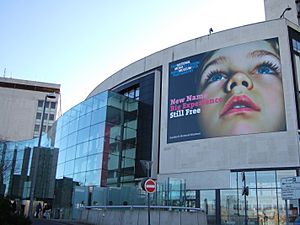
Bradford has a relationship with Bollywood. It hosted the International Indian Film Festival awards in 2007.
The Bradford Animation Festival is the UK's longest-running animation festival. It happens every November. The festival ends with the BAF Awards. These celebrate new animation from around the world.
The Cottingley Fairy photographs were taken by Elsie Wright. Two of the cameras used are on display at the National Science and Media Museum.
There are four theatres in Bradford. The Alhambra has a smaller studio theatre. The Theatre in the Mill is a small studio theatre at the University of Bradford. The Bradford Playhouse is a privately run venue.
Professional theatre companies in Bradford include Kala Sangam and Mind the Gap. Mind the Gap works with both disabled and able-bodied performers. Groups teaching theatre include The Asian Theatre School and Stage 84. There are also many amateur theatre groups.
St George's Hall is a concert hall from 1853. It is the oldest concert hall in Britain. The Bradford Festival Choral Society was founded to perform there. The Hallé Orchestra has visited regularly. Many popular musicians and comedians also perform there. In 2017, an £8.2 million renovation of St George's Hall began. It reopened in late 2018.
Cinemas have been replaced by large entertainment complexes. The Leisure Exchange has a 16-screen Cineworld. The Odeon Leeds-Bradford has 13 screens. The University of Bradford also has a cinema run by its Students' Union.
Bradford's nightlife used to be around Manor Row. More recently, clubs and pubs have opened in the West End. This area is now often busy at night. North Parade also has new themed bars. Sunbridge Wells is an underground leisure and retail complex. It opened in 2016.
Bradford was one of the first UK areas to get a local commercial radio station. This was Pennine Radio in 1975. Today, it is Hits Radio West Yorkshire. Bradford Community Broadcasting broadcasts around Bradford. The university radio station Ramair broadcasts to students. Bradford's only television station, AAP TV, serves the large Asian community. The Telegraph and Argus is Bradford's daily newspaper.
The Bradford Mela is now part of the bigger Bradford Festival in June. A mela is a gathering or meeting. In the UK, melas celebrate and share cultures. They include markets, funfairs, food, arts, and performances. Bradford held the first mela in Europe in 1988. It is now held in Bradford City Park.
Bradford City Park has the largest city center water feature in the UK.
Museums and Art Galleries
Bradford is home to the National Science and Media Museum. It celebrates cinema and movies. It is the most visited museum outside London. It has the UK's first IMAX theatre.
Bradford Industrial Museum opened in 1974. It celebrates Bradford's industrial past. This includes textiles, printing, and car making.
Bolling Hall Museum is a mile from the city center. It is a part-medieval building. Visitors can see how families lived there for over 500 years.
Bradford's main art gallery is in Cartwright Hall in Lister Park. Bradford 1 Gallery opened in 2007. It shows four temporary exhibitions each year.
Impressions Gallery is an independent photography gallery. It moved to Bradford in 2007.
City of Sanctuary
Bradford was recognized as a 'City of Sanctuary' on November 18, 2010. This means it is a place committed to welcoming people seeking safety. The city has a history of welcoming newcomers. For example, between 1938 and 1939, Bradford welcomed about 270 German Jewish refugee children. This was part of the Kindertransport scheme. Many children were first housed in a former hospital. Later, they moved to private homes.
Music Scene
Bradford is the hometown of rock bands like New Model Army, Smokie, and The Cult. It is also home to hip hop groups like Fun-Da-Mental and Bad Boy Chiller Crew.
Singer-songwriters Tasmin Archer, Teddy Sinclair, and Kiki Dee are also from Bradford. Kiki Dee was the first white British artist signed by Motown.
Since the 1980s, Bradford has been important in the UK's punk rock scene. This is mainly because of the 1 in 12 Club. This is a music venue and anarchist workers' cooperative.
In 2002, Gareth Gates came second in Pop Idol. He had four UK number one singles. Kimberly Walsh became famous after joining the girl band Girls Aloud. In 2010, Zayn Malik came third in The X Factor with his boy band One Direction. In March 2012, One Direction became the first British group to top the US music charts with their first album.
The guitar player and composer Allan Holdsworth was born in Bradford in 1946.
Bradford's Curry Capital Status
In 2013, Bradford was again named "Curry Capital of Britain." It beat cities like Glasgow and Wolverhampton. Bradford scored high for food quality, service, and hygiene. Judges were also impressed by Bradford's International Food Academy. This teaches residents how to cook healthy meals. The city has been voted the curry capital of the UK for six years in a row.
Sports in Bradford
Bradford has a long history in sports. Bradford Bulls, formerly Bradford Northern, is a very successful rugby league club. They have won the World Club Championship three times since 2002. They play at the Grattan Stadium, Odsal. The city also has rugby union clubs like Bradford Salem. The Richard Dunn Sports Centre is near Odsal.
Bradford City Football Club was formed in 1903. They won the FA Cup in 1911. They currently play in EFL League Two. The team's ground, Valley Parade, had a tragic fire on May 11, 1985. 56 people died. A second club, Bradford Park Avenue, also played in the Football League. They now play in the Northern Premier League.
Bradford Hockey Club plays in the North Hockey League.
Odsal Stadium also hosts BriSCA Formula 1 Stock Cars and BriSCA Formula 2 Stock Cars races. Stock car racing started there in 1945. The sport was revived at Odsal in 2021.
The former Bradford Dukes speedway team raced at Odsal until 1997. Speedway was also held at Greenfields Stadium. Odsal hosted a Speedway World Final.
The Bradford Dragons are the city's basketball team. They play in the second tier English Basketball League Division 1. Their home games are at Bradford College.
The city has a history of skateboarding culture. In a 2012 book, it was called "West Yorkshire's de facto skate capital."
Joe Johnson, a retired professional snooker player from Bradford, won the 1986 World Snooker Championship.
Jasmin Atker is a Bradford student. She captained the first England team in the international Street Child Cricket World Cup. She was named one of the BBC 100 top inspiring women in 2019.
Public Services in Bradford
There are two main hospitals in Bradford: Bradford Royal Infirmary and St Luke's Hospital. Both are teaching hospitals. They are run by Bradford Teaching Hospitals NHS trust.
Bradford is part of a large study called Born in Bradford. This study tracks the lives of babies born in the city from 2006 to 2008. It aims to provide data for health research.
Famous People from Bradford
Many famous people were born in Bradford. David Hockney, a famous painter and artist, was born and educated here. Frederick Delius (1862–1934) was a composer. J.B. Priestley (1894–1984) was a novelist and playwright. Sir William Rothenstein was a painter and writer. He was head of the Royal College of Art. In classical music, Rodney Friend (born 1940) became the youngest leader of the London Philharmonic Orchestra.
In science and medicine, Friederich Wilhelm Eurich (1867–1945) helped fight anthrax in the wool trade.
Sir Edward Appleton (1892–1965) discovered the ionosphere. He won a Nobel Prize. Robert Turner (1923–1990) was a pathologist. He pioneered chemotherapy for cancer treatment at the Bradford Royal Infirmary.
In industry, Sir Jacob Behrens (1806–1889) helped Bradford become a major wool exporter.
Richard Oastler (1789–1861) was a social reformer. He campaigned against child labor. A statue and a shopping center are named after him. W.E. Forster (1818–1886) was an MP for Bradford. Forster Square is named after him.
In recent pop culture, Zayn Malik, a former member of One Direction, was born and raised in Bradford. American film star Aasif Mandvi grew up in Bradford.
Bradford's International Connections
Bradford is twinned with several places around the world:
- Skopje, North Macedonia (since 1963)
- Roubaix, France (since 1969)
- Verviers, Belgium (since 1970)
- Mönchengladbach, Germany (since 1971)
- Galway, Ireland (since 1987)
- Mirpur, Azad Kashmir, Pakistan (friendship agreement in 1998)
- Varna, Bulgaria (since 1992)
Images for kids
See also
 In Spanish: Bradford para niños
In Spanish: Bradford para niños
- Bradford City stadium fire
- List of Pals battalions
- Listed buildings in Bradford
- BD1 Gallery


